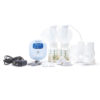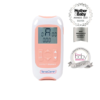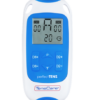Breastfeeding at Night – How Do You Know When to Stop?

Breastfeeding at Night – How Do You Know When to Stop?
Have you been told that your baby doesn’t need, or shouldn’t be breastfeeding at night past a certain age? The age in question tends to vary depending on the well-meaning advisor. However, science tells us that in many cases, this simply isn’t true.
All babies and mothers are unique, and your differences affect your baby’s need for night feedings. Some babies need to breastfeed at night, whether they’re six months, eight months, or beyond. Night feedings are particularly common for moms with small “breast storage capacity”. Understanding the basics of how milk production works will help clarify what this means and if it applies to you.
The two basic dynamics that influence your milk production
Degree of Breast Fullness
The first, “degree of breast fullness,” refers to a simple concept: drained breasts make milk faster and full breasts make milk slower. Whenever your breasts contain enough milk to feel full, your milk production slows.1 The fuller your breasts become, your body receives the signal to slow down milk production. This is why pumping can help increase milk supply.
How quickly your body produces breast milk is directly related to whether your breasts are full, or drained. When your breasts contain enough milk to feel full, your milk production slows.1 If they are fully drained, your body then increases milk production. This concept explains how pumping helps increase your milk supply.
Breast Storage Capacity
The second dynamic refers to a physical characteristic known as breast storage capacity, which varies among mothers. This biological difference is the reason why feeding patterns among mothers differ, and why some breastfed babies do not need to breastfeed at night while others do.
Breast storage capacity is the amount of milk your breasts contain in your milk-making glands at their fullest point of the day. Storage capacity is not related to breast size. Breast size is mainly determined by how much fatty tissue is in your breasts, not by your milk-producing glands. So smaller-breasted mothers can have large-capacity storage, and larger-breasted mothers can have small-capacity storage.
Whichever amount of storage your body has, it will produce plenty of milk for your baby. But babies will feed differently to get the daily volume of breast milk they need.3
Large Storage Capacity
If you have large storage capacity, you may notice that after the first month of breastfeeding, your baby:
• Is satisfied with one breast at most or all feedings
• Is finished breastfeeding much sooner than other babies (sometimes just five minutes
• Gains weight well on fewer feedings per day than the average eight or so
• Sleeps for longer-than-average stretches at night
If this describes your breastfeeding experience, your baby may already be sleeping for longer stretches at night than other babies you know.
Small Storage Capacity
Alternately, you most likely have a storage capacity on the small to average side if after the first month of breastfeeding you notice that your baby often:
• Takes both breasts at feedings
• feeds on average longer than about 15 to 20 minutes total
• typically takes eight or more feedings per day
• wakes at least twice a night to breastfeed
How storage capacity affects breastfeeding patterns
The most important factor contributing to your baby’s healthy growth is not how much milk he receives at each feeding, but rather how much milk he consumes in a 24-hour day. Breastfed babies of both large and small-capacity mothers receive plenty of milk, but their breastfeeding patterns will differ to gain weight and thrive.4 For example, a baby whose mother’s breasts holds six ounces or more (180 mL) may grow well with as few as five feedings per day. Whereas, if the mother’s breasts hold three ounces (90 mL), their baby will need to feed ten times each day.
Breast storage capacity is much less of a factor if you are pumping. You can measure pumped milk much easier as bottles and storage bags all have markers to indicate the number of ounces (mL’s) a baby is taking.
How These Dynamics Affect Night Feedings
How does this all apply to night feedings? A mother with a large storage capacity has the room in her milk-making glands to comfortably store more milk at night before it exerts the amount of internal pressure needed to slow her milk production. On the other hand, if the baby of the small-capacity mother sleeps for too long at night, her breasts become so full that her milk production slows.
In other words, if you have average or small breast storage capacity, night feedings may need to continue for many months for your milk production to stay stable and for your baby to thrive. Also, because your baby has access to less milk at each feeding, night feedings may be crucial for them to get enough milk overall. What’s important is not how much milk a baby receives at each feeding, but how much milk he consumes in a 24-hour day.
Note: If you have small storage capacity and are using sleep training strategies to encourage baby to go for longer stretches between feedings, this can result in decreased milk production and slower growth for your baby.
There is no standard to follow
Each mom and baby duo is unique, and babies will outgrow the need for night feedings at different ages. Trying to apply a standard rule of thumb doesn’t take into consideration the emotional needs of the baby nor their physical need for milk.
Adapted from Nancy Morbacher, the Breastfeeding Reporter
References
1Daly, S. E., Kent, J. C., Owens, R. A., & Hartmann, P. E. (1996). Frequency and degree of milk removal and the short-term control of human milk synthesis, Experimental Physiology, 81(5), 861-875.
2Cregan, M. D., & Hartmann, P. E. (1999). Computerized breast measurement from conception to weaning: clinical implications. J Hum Lact, 15(2), 89-96.
3Kent, J. C., Mitoulas, L. R., Cregan, M. D., Ramsay, D. T., Doherty, D. A., & Hartmann, P. E. (2006). Volume and frequency of breastfeedings and fat content of breast milk throughout the day, Pediatrics, 117(3), e387-395.
4Kent, J. C. (2007). How breastfeeding works. Journal of Midwifery & Women’s Health, 52(6), 564-570.





